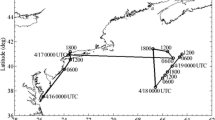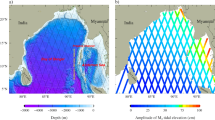Abstract
The formation of arc-type structures in the surface elevation and temperature fields due to internal tidal (IT) waves is studied in the region of the South China Sea (SCS) and Luzon Strait. It is demonstrated that these arc-type structures in the surface elevation and temperature at depth result from the merging of IT waves. Predictions of internal baroclinic tides are conducted with a nonlinear hydrostatic model, the Luzon Strait Nowcast/Forecast System, forced with tides, realistic surface forcing and stratification (Appendix 1). It is shown that IT waves generated by the undersea ridges near the Batan and Babuyan Islands in the Luzon Strait propagate westward and merge into arcs in the SCS. The superposition of IT waves is also investigated with a linear knife-edge model (Appendix 2). M2 and K1 tidal waves are considered. It is demonstrated that K1, M2 tidal waves from the Babuyan Islands combine with waves from the Batan Islands to form arc signatures in sea surface elevation and warm spots in the South China Sea. Possible modulation effects of K1 waves on M2 waves are shown. Dynamics of the nonlinear hydrostatic model shape the arc segments differently from the linear model. Arc lengths increase from the sources in nonlinear and linear models. The model-predicted merged IT waves are compared with SAR images.










Similar content being viewed by others
References
Buijsman MC, McWilliams JC, Jackson CR (2010) East-west asymmetry in nonlinear internal waves from Luzon Strait. J Geophys Res 115:C10057. doi:10.1029/2009JC006004
Buijsman M, Legg S, Klymak J (2012) Double ridge internal tide interference and its effect on dissipation in Luzon Strait. J Phys Oceanogr 42:1337–1356
Chao S-Y, Ko DS, Lien R-C, Shaw P-T (2007) Assessing the west ridge of Luzon Strait as an internal wave mediator. J Oceanogr 63:897–911. doi:10.1007/s10872-007-0076-8
Chen Y-J, Ko DS, Shaw P-T (2013) The generation and propagation of internal solitary waves in the South China Sea. J Geophys Res 118:6578–6589. doi:10.1002/2013JC009319
Echeverri P, Yokossi T, Balmforth NJ, Peacook T (2011) Tidally generated internal-wave attractors between double ridges. J Fluid Mech 669:354–374
Egbert G, Erofeeva S (2002) Efficient inverse modeling of barotropic ocean tides. J Atmos Ocean Tech 19:183–204
Farmer D, Li O, Park J-H (2009) Internal wave observation in South China Sea: the role of rotation and nonlinearity. Atmos-Ocean 47:267–280. doi:10.3137/OC313.2009
Farmer DM, Alford MH, Lien R-C, Yang Y-H, Chang M-H, Li Q (2011) Stages in the life of an internal wave. Oceanography 24:64–77
Flather RA, Proctor R (1983) Prediction of North Sea storm surges using numerical models: recent developments in the UK. In: Sundermann J, Lenz W (eds) North Sea dynamics. Springer, New York, pp 299–317
Hsu M, Liu A (2000) Nonlinear internal waves in South China Sea. Can J Remote Sensing 26:72–81
Jackson CR (2009) An empirical model for estimating the geographic location of nonlinear internal solitary waves. J Atmos Oceanic Technol 26:2243–2255. doi:10.1175/2009JTECHO6381
Jackson CR (2014) Separation of SAR observations into A and B waves. Private communication
Ko DS, Wang D-P (2014) Intra-Americas Sea nowcast/Forecast System Ocean reanalysis to support improvement of oil-spill risk analysis in the gulf of Mexico by multi-model approach, BOEM 2014-1003. Bureau of Ocean Energy Management, Herndon, VA, pp 55
Ko DS, Martin PJ, Rowley CD, Preller RH (2008) A real-time coastal ocean prediction experiment for MREA04. J Mar Syst 69:17–28. doi:10.1016/j.jmarsys.2007.02.022
Ko DS, Chao S-Y, Huang P, Lin SF (2009) Anomalous upwelling in Nan Wan: July 2008. Terr Atmos Ocean Sci 20:839–852. doi:10.3319/TAO.2008.11.25.01(Oc)
Ko DS, Chao S-Y, Wu C-C, Lin I-I (2014) Impacts of Typhoon Megi (2010) on the South China Sea. J Geophys Res Oceans 119:4474–4489. doi:10.1002/2013JC009785
Laurant LC, Stringer S, Garret C, Perrault-Joncas D (2003) The generation of internal tides at abrupt topography. Deep Sea Res I 50:987–1003
Lee I-H, Ko DS, Wang Y-H, Centurioni L, Wang D-P (2013) The mesoscale eddies and Kuroshio transport in the western North Pacific east of Taiwan from 8-year (2003–2010) model reanalysis. Ocean Dyn 63:1027–1040. doi:10.1007/s10236-013-0643-z
Li Q (2014) Numerical assessment of factors affecting nonlinear internal waves in South China Sea. Prog Oceanogr 121:24–43
Li Q, Farmer DM (2011) The generation and evolution of nonlinear internal waves in the deep basin of the South China Sea. J Phys Oceanogr 41:1345–1363
Liu A, Ramp S, Zhao Y, Tang Y (2004) A case study of internal solitary wave propagation during ASIAEX 2001. IEEE J Ocean Eng 29:1144–1156
Ma BB, Lien R-C, Ko DS (2013) The variability of internal tide in the northern South China Sea. J Oceanogr 69:619–630. doi:10.1007/s10872-013-0198-0
Martin PJ (2000) A description of the Navy Coastal Ocean Model Version 1.0, NRL. Rep. NRL/FR/7322-00-9962. Nav Res Lab Stennis Space Cent., MS, pp 42
Niwa Y, Hibiya T (2004) Three-dimensional numerical simulation of M2 internal tides in the East China Sea. J Geophys Res 109:C04027. doi:10.1029/2003JC001923
Qian H, Shaw P-T, Ko DS (2010) Generation of internal waves by barotropic tidal flow over a steep ridge. Deep Sea Res I 57:1521–1531. doi:10.1016/j.dsr.2010.09.001
Rainville L, Johnston S, Carter TM, Merrifield GS, Pinkel MA, Worcaster PF, Dushhaw BD (2010) Interference pattern and propagation of the M2 internal tide south of the Hawaiian Ridge. J Phys Oceanogr 41:311–325. doi:10.1175/2009JPO4256
Ramp S, Tang T, Duda T, Lynch J, Liu A, Chiu C-S, Bahr F, Kim H-R, Yang Y-J (2004) Internal solitons in the Northeastern South China Sea Part 1: sources and deep water propagation. IEEE J Ocean Eng 29:1137–1181
Ramp S, Yang Y, Bahr F (2010) Characterizing the nonlinear internal wave climate in the northeastern South China Sea. Nonlin Proc Geophys 17:481–498. doi:10.5.5194/npg-17-481-2011
Rhodes RC, Hurlburt HE, Wallcraft AJ, Barron CN, Martin PJ, Smedstad OM, Cross S, Metzger EJ, Shriver J, Kara A, Ko DS (2002) Navy real-time global modeling system. Oceanography 15:29–43. doi:10.5670/oceanog.2002.34
Simmons H, Chang M-H, Chang Y-T, Chao S-Y, Fringer O, Jackson CR, Ko DS (2011) Modeling and prediction of internal waves in the South China Sea. Oceanography 24:88–99. doi:10.5670/oceanog.2011.97
Warn-Varnas A, Hawkins J, Lamb KG, Piacsek S, Chin-Bing S, King D, Burgos G (2010) Solitary wave generation dynamics at Luzon Strait. Ocean Model 31:9–27. doi:10.1016/j.ocemod.2009.08.002
Zhang Z, Fringer OB, Ramp S (2011) Three-dimensional nonhydrostatic numerical simulation of nonlinear internal wave generation and propagation in the South China Sea. J Geophys Res 116:C05022. doi:10.1029/2010JC006424
Zheng Q, Susanto RD, Ho C-R, Song YT, Xu Q (2007) Statistical and dynamical analyses of generation mechanisms of solitary internal waves in the northern South China Sea. J Geophys Res 112:C03021. doi:10.1029/2006JC003551
Zheng Q, Song YT, Lin H, Hu X, Meng J, Wang D (2008) On generation source sites of internal waves in the Luzon Strait. Acta Oceanol Sin 27:38–50
Acknowledgments
The work was supported by the Office of Naval Research under PE62435N for AWV and N00014-05WX-2-0647 for DSK, with technical management provided by the Naval Research Laboratory. We thank Gretchen Dawson and Paul Martin for the early NCOM predictions and analysis. Helpful comments from two anonymous reviewers are appreciated.
Author information
Authors and Affiliations
Corresponding author
Appendices
Appendix 1: Hydrostatic model (LZSNFS)
The LZSNFS (Luzon Strait Nowcast/Forecast System) is an integration of a data-assimilating, dynamical ocean model, a statistical data-analysis model, and various data streams for ocean bathymetry, climatological data, surface forcing, open boundary forcing, and observations for data assimilation (Ko et al. 2008). The dynamic ocean model in the system is the Navy Coastal Ocean Model (NCOM) (Martin 2000), developed at Naval Research Laboratory (NRL) and in operation at the US Naval Oceanographic Office in various configurations (Rhodes et al. 2002). NCOM is a hybrid sigma/z-level primitive equation, free-surface model, applying the hydrostatic, incompressible, and Boussinesq approximations. This model is similar in its physics and numeric to the Princeton Ocean Model (POM), but uses an implicit treatment of the free surface.
The LZSNFS model domain covers the Luzon Strait, northern South China Sea and part of the western North Pacific Ocean (Fig. 3) with ~2.3 km horizontal resolution. There are 41 sigma-z levels in the model; 19 sigma layers are used from the surface down to a depth of 147 m, and z-levels are used below. The model ocean topography is derived from the NRL global Digital Bathymetry Data Base 2-min (DBDB2) (http://www7320.nrlssc.navy.mil/DBDB2_WWW/), with improvement by blending high resolution bathymetry data from the Ocean Research Center at National Taiwan University.
The LZSNFS applies the East Asian Seas Nowcast/Forecast System (EASNFS; Ko et al. 2009; Lee et al. 2013; Ko et al. 2014) that covers entire East Asian Marginal Seas for open boundary conditions (BCs). The EASNFS for this application does not include tides. To simulate internal tides/waves, LZSNFS are forced with tidal heights and transport of eight tidal harmonics (K1, O1, P1, Q1, M2, S2, K2, and N2) taken from TPXO7.2 (Egbert and Erofeeva 2002). Tides are applied to model depth-averaged normal velocity u, with elevation η, at open boundary by combining forcing from EASNFS using a forced radiation BC modified from Flather and Proctor (1983):
where subscript R and t denote variables from the regional model (EASNFS) and from the tidal model, respectively, and c is the barotropic wave phase speed: \(c = \sqrt {gh}\), with g being the gravitational constant and h the water depth. For the BCs of tangential velocity, temperature and salinity, the first-order-upwind advection scheme was utilized.
The atmospheric forcing consists of air pressure, wind stress, solar radiation, and heat fluxes from Coupled Ocean/Atmosphere Mesoscale Prediction System (COAMPS), a high-resolution Navy operational regional weather forecast model.
LZSNFS assimilates satellite altimeter data to produce Kuroshio and mesoscale eddies that have been shown to have an impact on the generation and propagation of large amplitude internal waves (e.g., Ma et al. 2013). A vertical weighting function and a scale separation scheme are applied for the data assimilation to prevent attenuation of high frequency internal tides/waves (Chen et al. 2013; Ko and Wang 2014).
Appendix 2: Knife-edge model
The knife-edge model represents the baroclinic surface elevation in cylindrical coordinates as:
where r is the distance from the center, Ϛ 0 amplitude of baroclinic surface elevation at r 0 and ϕ 0 arbitrary phase. Equation evaluated for r > r 0 Wave is evaluated for r > r 0. Wave is prevented from radiating in all directions by assigning length a 0, direction 0 with range \(\;\theta_{0} \pm (a_{0} /2r_{0} ),\;{\text{and}}\;\varsigma = 0\;{\text{elswhere}}\).
A ridge where generation occurs can be represented by a line source. Generation from several ridges can be superposed with this knife edge model. Propagation angle is established by the strongest barotropic tidal current direction. The phase is chosen for baroclinc currents to have the same phase as the maximum cross ridge barotropic tide. The wavelengths are calculated based on stratification used in model. The surface elevation is determined for the generated wave at the line source to carry the energy across the channel predicted by the knife-edge model (Rainville et al. 2010). Phases ϕ 0 are derived from the OSU (University of Oregon) tidal model.
Rights and permissions
About this article
Cite this article
Warn-Varnas, A., Ko, D.S. & Gangopadhyay, A. Signatures of tidal interference patterns in the South China Sea. J Oceanogr 71, 251–262 (2015). https://doi.org/10.1007/s10872-015-0282-8
Received:
Revised:
Accepted:
Published:
Issue Date:
DOI: https://doi.org/10.1007/s10872-015-0282-8




